By Lee Tulloch
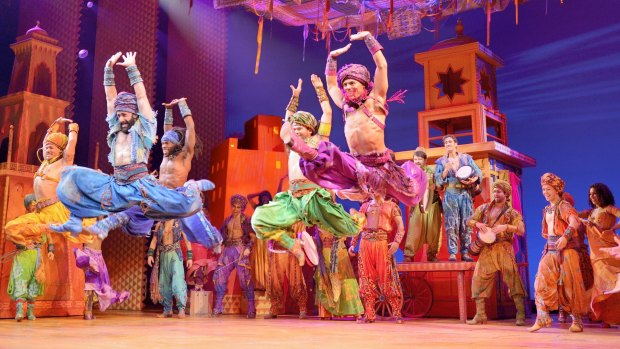
Performers in the Disney production of Aladdin.
It's not often a writer gets to travel on Aladdin's magic carpet, but that's one way to describe my latest trip. I have been whisked from Sydney to New York and back again, by way of Morocco, on a ride that feels every bit as thrilling as if a big, jolly genie had provided the mode of transport.
The reason for my expedition is the opening of the Australian production of Disney's Aladdin, which will premiere in Sydney on August 12. The live action musical version of the much-loved cartoon feature, which stars the unforgettable Robin Williams as the voice of the Genie, opened on Broadway in 2014 and has been replicated in London, Tokyo and Hamburg, making the Australian production the fifth worldwide.
I have been invited to fly to New York to see the Broadway show, meet the team behind the production and then wing my way back to Sydney to visit the inner city workshop where the opulent costumes are being made. I do it on an A380, more flying whale than carpet, but the experience is magical nevertheless.
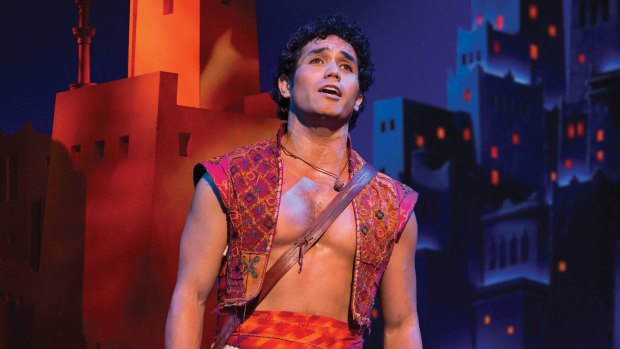
Adam Jacobs in Aladdin.Credit: Deen van Meer
And Morocco? My carpet doesn't make a physical stop there but the musical's fictional city of Agrabah, Aladdin's hometown, is a flamboyant, high camp reimaging of Marrakech, which the show's designers visited when they were conceptualising the production.
The stage version of this ''city of mystery and enchantment'', as the opening number describes it, is not anything you'd find in a Lonely Planet Guide (it's more Bing Crosby and Bob Hope's Road to Morocco than reality) but the dazzling stage settings and astoundingly beautiful costumes have been created to capture the spirit of ''joyfulness'' found in the sensual North African city, according to costume designer Gregg Barnes.
I touch down on Broadway, in orchestra seats at the historic New Amsterdam Theatre, which was once the home of the Ziegfeld Follies. After 1937 it became a movie theatre but it fell into disuse in the 1980s. Disney extravagantly restored it and reopened it in 1997 as a live theatre venue for their productions. It also houses the corporation's offices above the theatre, in a space that was once host to Ziegfeld's Midnight Frolic, an X-rated revue.
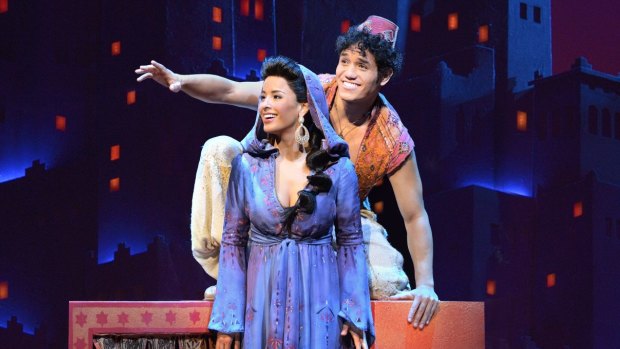
Courtney Reed and Adam Jacobs in the Disney production of Aladdin.Credit: Deen van Meer
Almost everyone knows the popular children's story of Aladdin, the street rat who wins the heart of a princess with the aid of a stolen magic lamp and its genie. The stage musical, with music by Alan Menken and lyrics by Howard Ashman and Tim Rice, is cleverly directed by Casey Nicholaw, best known for his Tony Award® -winning direction of The Book of Mormon. It is fantastically entertaining, with enough belly laughs and witty asides to keep the adults in the audience entertained as much as the children. The friend I bring with me to see the show is a designer who is hard to please, but she pronounces the production values ''exquisite'', especially the show's visual highlight, the magic carpet ride, when Aladdin and Princess Jasmine are swept away against a starry sky. Before the last dervish has whirled, the entire audience is on its feet, applauding madly.
As gorgeous as Aladdin might be from my view in the stalls, it's only when I go backstage a few days later that I understand the phenomenal creativity and attention to detail that has gone into the design aspects of the production.
I love backstage at any theatre and this one is especially thrilling. Fanny Brice and Josephine Baker once waited in the wings here. The backstage area is a rabbit warren, with higgledy-piggledy corridors and anterooms stuffed to the gills with glittering costumes, swords, market carts, filigree metal sets and feathered fans worthy of Ziegfeld.
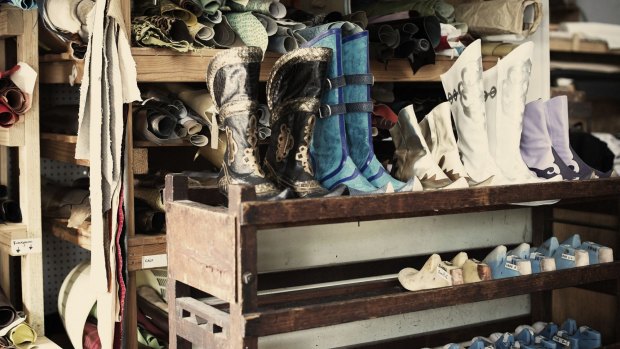
Aladdin costume workshop.
There are 337 costumes in the show, 137 of them individual designs, all exuberant riffs on ''Arabic'' clothing, from fezzes and brocade turbans to harem pants and jewelled skirts. The garments use 1222 different fabrics, imported from nine countries. The attention to detail is such that there's a bin allocated for each performer, full of the spare beads that match his or her costume. Costumes are carefully examined after each performance and missing beads are hand-sewn back on by a team of tailors.
When I meet costume designer Gregg Barnes in a rehearsal room above the theatre he says, ''It's one of the blessings of working with Disney that they care about this stuff. After we did it I used to sit in the audience and think 'Oh my gosh, the thought of ever doing it again!", I just want to pass out, because it was such a monumental undertaking.''
Barnes, who has just won an Olivier Award for his designs for Kinky Boots (coming to Melbourne in October), was part of the team that went on a research trip to Marrakech in 2013, along with lighting designer Natasha Katz, director and choreographer Casey Nicholaw, hair designer Josh Marquette and Disney Theatrical Productions president Thomas Schumacher.
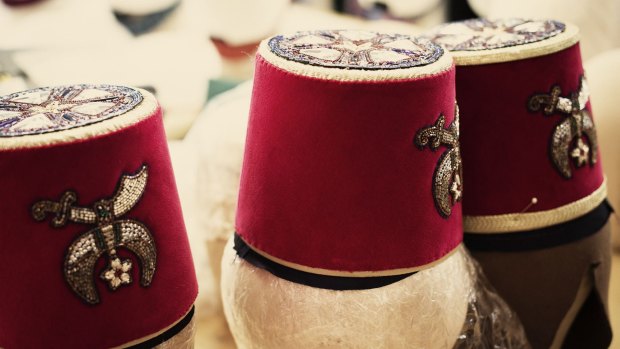
Aladdin costume workshop.
The crew stayed in a beautiful riad, visited the souks and workshops of local artisans and dined in some spectacular locations, including a private home where the host offered them glasses of champagne and then pushed a button so that the roof retracted and exposed the starry sky. This no doubt inspired the flying carpet scene.
''We decided early in the process that we would try to make a fictional place that felt like it was at a crossroads to a lot of cultures like the silk trail was,'' Gregg Barnes says. ''So we looked at India, China, Japan, the Middle East, Morocco and Northern Africa and we tried to find a common vocabulary, using decorative elements from all those cultures.''
He'd been to Morocco once, as an 18-year-old, on a trip with his aunt. ''Around every corner is an adventure. It's like the most gorgeous chaos of all time.'' This time, he was struck by the ''great craftsmanship'' and the way the Moroccans put colour together. The rainbow colour palette of the market scenes in the opening dance number modulates into lavenders, blues, and silvers for the palace and scintillating golds for Aladdin's cave.
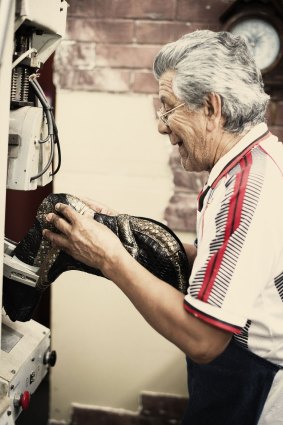
Aladdin costume workshop.
The supersaturated lighting of the scenic design existed more in her imagination than the true light of Marrakech, says lighting designer Natasha Katz, although the creative team was influenced by the brilliant blues of Yves Saint Laurent's former residence, Jardin Majorelle, now a museum. The effect of pinpoints of light shining through traditional perforated lamps was also a big influence. ''It evokes a kind of magical feeling,'' Katz says.
''Everybody felt Morocco was a sensual place,'' Barnes says. ''There's a lot of skin, there are a lot of light fabrics.'' It was important to collaborate with associate choreographer John MacInnis to make sure all those layers – skirts, shawls, scarves – would dance. 'We made all different kinds of harem pants and we found that some of them in a wonderful way would catch the air like elephants' ears and when they spun they would balloon up. So we were trying to find things that felt like they had a life that breathed.
''Of course, it costs a lot of money, and it costs a lot of money to maintain the costumes, but if you're going to make a belt and it is meant to be from a decorative culture, you might as well make the elements add up to something beautiful, even if you're not aware of it so much from the house.''
Barnes says the quality of the costumes helps the actors feel the part. The actress who understudies Princess Jasmine on Broadway, Tia Altinay, started to cry when she was being fitted for her new Broadway costume. ''We worried that she must have hated it or something, but she said, 'Now I really feel like a princess.'.''
My magic carpet now takes me from Broadway back to inner city Sydney to visit the Sydney Costume Workshop, where costumes for the Australian production are being made.
The workshop is run by costume supervisor Janet Hine, who has had an illustrious 20-year career as costume designer and supervisor, working on productions such as Sweet Charity, Saturday Night Fever, Hairspray and Burn the Floor (Broadway and West End.)
If you've stayed at a QT hotel recently, she's the person responsible for the snazzy uniforms of hotel staff. ''I do princes and presidents,'' she jokes, referring to 2014 when she dressed world leaders, including Vladimir Putin, for the G20 summit in Sydney.
Hine oversees 70 workers in two workshops. Her staggering task is to make sure the hundreds of costumes for Australia replicate as closely as possible those in the original Broadway production. While there are slight variations due to practical issues, such as the availability of fabrics, and some improvements in design (fabric patterns are now digitally printed rather than hand-stencilled, which makes the costumes lighter), pretty much every seam and embellishment, and there are thousands upon thousands of details, is a duplicate of Gregg Barnes' original designs.
Hine shows me ''the bible'' which includes sketches of every costume in the musical, plus reference photographs of the actors in costume and fabric swatches. It runs to more than a dozen books. In the opening market scene alone there are costumes for 14 males and nine females, each with several pieces, from boleros to shawls, not to mention the hand-made shoes, headpieces and wigs, which are being fashioned in the Canal Road workshop in Leichhardt.
''They don't make shows like this anymore,'' Janet Hine says. An extraordinary amount of technical expertise is needed to carry it off. Patterns are adjusted to the individual actors' bodies by computer program; the insides of skirts are airbrushed so the colour is correct when they swirl; suede vests are intricately hand-woven and then appliqued. ''It's insane.''
To carry it off, her team of people need to be multi-skilled, able to sew, bead, cut fabric and make patterns, so that they can ''ebb and flow'' through the production and fitting process, avoiding logjams that might happen with such a complicated project. ''I have to think on my feet. Everything changes all the time.''
It sounds like it's as chaotic as a Moroccan bazaar, but the workshop itself is surprisingly calm, with everyone quietly going about cutting, sewing and beading. Hine says Australians are known as great artisans and ingenuity is their strong suit. ''We have to think outside the square. We can't walk down to 38th Street [in New York's fashion district] to get a button.''
Aladdin is pure fantasy, of course, but there is one authentic Arabic connection. Hine commissioned a workshop in Qatar to do some of the hand embroidery on the costumes. The day I'm visiting, panels of silver and gold-embroidered fabric have just arrived from Doha, ready for sewing together as the Sultan's robes. The embroidery and beading is ''film quality'', which means it would survive any close-up. ''Normally for the stage it would just be sequins stuck on,'' she says.
I'm a little reluctant to leave this real-life Aladdin's cave when the time comes. There's no carpet waiting for me outside: I'm obviously all out of wishes.
But Aladdin will soon spin its magic at the Capitol Theatre and alternate means of transport will be provided.
TRIP NOTES
MORE INFORMATION
For Aladdin tickets: capitoltheatre.com.au/aladdin
Visiting Broadway: nycgo.com
STAYING THERE
New York: The Knickerbocker Hotel on 42nd Street at Times Square is a short stroll from the New Amsterdam Theatre. The recent renovation of a neglected gem brings it to five-star status and windows enjoy singular views of the dazzling neon (blackout blinds provided). A fabulous rooftop bar and an excellent pre-theatre dinner menu make this the perfect residence for Broadway babies. knickerbocker.com
Marrakech: The Disney team stayed at La Maison Arabe, an elegant riad hidden in the heart of the medina behind high walls. Uniquely decorated rooms open on to terraces and flower-filled courtyards, with a heated swimming pool. Since it opened in 1946 it has been one of the city's most admired small hotels and the cooking school is legendary. lamaisonarabe.com
Sydney: Aladdin's costume supervisor Janet Hine created the theatrical ''uniforms'' worn by QT Sydney's concierges and door staff. The hotel, which occupies the spaces above the gilded State Theatre and what was once the Gowings menswear store, is ideally located in the main shopping precinct, a short walk from the Capitol Theatre. qthotelsandresorts.com
Aladdin's designers' favourite places
Jardin Majorelle
In the early 20th century, painter Jacques Majorelle created a beautiful garden, full of dramatic, curious plants, in this upscale neighbourhood in the city. Yves Saint Laurent acquired it in 1980 and restored it, painting the buildings and planters cobalt blue and yellow. A museum of Berber culture was opened on the property in 2011. jardinmajorelle.com
Bahia Palace
''Bahia'' means ''brilliance'' and this collection of houses and gardens was the greatest palace of its time when it was converted into a residence for the Grand Vizier in 1900. It is currently in use as a reception hall for dignitaries but visitors can see it for the princely sum of €1. palais-bahia.com
Museum of Marrakech
Housed in a restored 19th century palace with wonderfully restful courtyards and fountains, the museum holds exhibits of both modern and traditional Moroccan arts as well historical artefacts from Jewish, Berber and Arab cultures. museedemarrakech.ma
The Souks
Historically, the souks were divided by retail speciality – spices, carpets, metalwork and leather, for example – but these days they blend into each other, so it helps to have a guide. Morocco is famous for its artisans and the best buys include beautiful perforated lamps and soft slippers. Fake Aladdin lamps are best avoided.
Le Pavillon de la Piscine, La Mamounia
Famed hotel La Mamounia, an art deco gem, is set in three hectares of fragrant gardens. It was lavishly given a $A300 million overhaul a few years ago. Buffet lunch by the pool is recommended even if you're not staying there. lhw.com
Lee Tulloch travelled to New York courtesy of Disney.
Sign up for the Traveller Deals newsletter
Get exclusive travel deals delivered straight to your inbox. Sign up now.